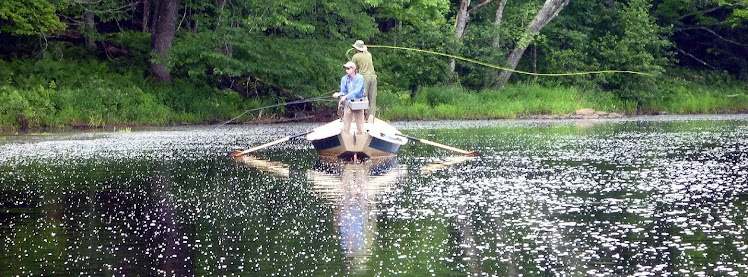The yearly annual fish survey of Iowa's Spring Branch Creek, located in Delaware County, was completed on April 26, 2014, during a workday held by members of both the Iowa DNR and the Hawkeye Fly Fishing Association. The following photographs and information track a single brown trout through the survey process. (Please see this link: http://strip-n-twitch.blogspot.com/2014/05/members-of-iowa-dnrand-hawkeye-fly.html for a 2nd post containing information about the workday, findings from the survey, and for more photographs.)
Mark Winn, Natural Resources Technician with the Iowa DNR, right, uses a backpack electroshocker to seek out and briefly stun fish inhabiting a .33 mile section of Spring Branch Creek prior to netting them. The fish are passed to the net of Martin Acerbo, HFFA member, left, who then transfers the fish to a water-filled bucket carried by Larry Niday, HFFA president.
A large, stunned brown trout is carefully netted by Mr. Winn. The fish had been holding unseen beneath a limestone shelf camouflaging a bank hide. This is a prime example of how electrofishing techniques can increase fish capture rates during a stream survey, allowing data collection that is more reflective of the fishery.
Mr. Acerbo carefully removes the large brown trout from the net and transfers it to a bucket of stream water.
Already reviving, the brown trout begins to work its way to the bottom of the bucket.
The large brown trout submerges surprisingly well into the bottom of the bucket with other collected fish. Next, the shore crew will transfer the fish to a larger tub of water. Data for each trout will be recorded. Population totals each of brown, brook and rainbow trout, & non-game fish, such as suckers, creek chubs, sculpin, and brook stickleback will also be recorded.
Dan Kirby, Iowa DNR Natural Resources Biologist, right, measures the length of the large brown trout. Kate Lodge, an HFFA member, prepares to use a PIT tag reader to scan the abdomen of the fish. All brown trout collected during this survey were scanned for a PIT (Passive Integrated Transponder) tag. During the July 2013 stream survey, 100 brown trout were implanted in the abdomen with a PIT tag. Each tag individually identifies a fish and allows for the opportunity of year-to-year data comparisons.
The individual weight of the large brown trout and of each brown, brook, and rainbow trout is recorded in kilograms. The large brown trout was one of 27 browns found to contain a PIT tag. One hundred seven brown trout were collected during this year's survey.
Due to the use of PIT tags, it was established that the large brown trout grew 1.1 inches and weighed 1.8 pounds more than when it was surveyed 10 months ago. For a fish of this size, this is considered to be a good rate of growth. This Iowa Driftless brown, estimated at 5 years & likely older, measured 21.5 inches and weighed 4.2 pounds during this year's survey.
The brown trout is safely released back to the stream.
Why conduct fish surveys?
“Much
wildlife can be easily observed (e.g., songbirds, whitetail deer, waterfowl),
but fish present challenges because they are out of sight under the water
surface—this is the principal reason we use specialized fishing gear and
surveys to gather information used for fishery management.
We conduct
surveys for a variety of objectives. The
primary reason that we do surveys is to track the abundance, size structure,
and health of populations of game species such as brown trout and smallmouth
bass. Fish surveys are also commonly
used to assess the environmental heath of streams and rivers. In some cases, fishery surveys are used for
specific research such as to assess the impact of a management action.” ~ Dan Kirby, Natural Resources Biologist, Iowa DNR
Please see this link: http://strip-n-twitch.blogspot.com/2014/05/members-of-iowa-dnrand-hawkeye-fly.html for a 2nd post containing information about the workday, findings from the survey, and for more photographs.










No comments:
Post a Comment
Hi. I appreciate and welcome comments on this blog!
To keep it quick, I don't use word verification prior to your posting a comment. Since most spam comments are made anonymously, I just delete anonymously-posted comments. Thanks!